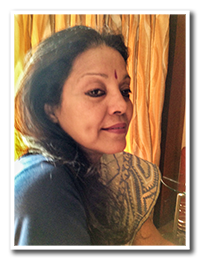

About
Born in Calcutta, Samita comes from a family of writers, painters and musicians. Her father, the late Mangala Charan Chattopadhyay, was a renowned Bengali poet who won many prestigious literary awards in his lifetime. He was an active member of the Progressive Writers’ Association, which brought Samita in close contact with many leading Bengali intellectuals of the time, her association with them stoking the fires of her own creative passions.
“Many poets, artists and intellectuals – like Mrinal Sen, Shombhu Mitra and Subhash Mukhopadhyay – used to come to our house during my schooldays,” Samita recalls. “There used to be long, heated discussions on various subjects – poetry, cinema, contemporary writing, politics – that went on till late in the evening. It was a great setting to grow up in.”
Despite the politically charged ambience of her home, Samita herself did not develop any strong political leanings because she has always believed that pure art concerns itself with things of more permanent and durable relevance. “A passing political event cannot have any lasting effect. I want to be able to arrive at an artistic statement that is more reflective of our lives than the impermanence of a moment in time,” she says. “Art must have a quality of timelessness. It may touch upon contemporary events but it must go beyond them to create an indelible impression. A painting has to delve deeper – into feelings, emotions and human motivations.”
At heart, Samita is a storyteller, her work marked by a deep empathy for the characters that dot her narrative landscape, particularly her female protagonists. Through their eyes, she reflects upon the human condition and paints stories that are sometimes dark, sometimes brazen, sometimes despairing, sometimes vivacious but, in their telling, always truthful.
Her paintings, specifically of women, capture snapshots from life, images of an ordinary person’s journey – perhaps, from the depths of abuse, neglect and abandonment, through a labyrinth of doubt and fear to a pinnacle of strength, self-sufficiency and independence and an extraordinary confidence in her own sexuality – a transformation fuelled by the knowledge that only a woman can perform the multifaceted role that life has bestowed upon her: affectionate daughter, sacrificing mother, diligent homemaker, sensuous companion, confident breadwinner and compassionate caregiver, all in one.
Essentially self-taught, Samita benefitted from and honed her skills under private tutelage and the mentorship of her uncle, the late Indoo Prakash Mukherjee, an artist of repute in his own right. Specialising in figurative work and portraiture, she is equally proficient in oils, charcoal and pastel though, of late, she prefers to work more with charcoal and conte pencil than other media.
Since her debut in 1994, Samita has had nine successful solo exhibitions and participated in at least two dozen group shows most of her paintings going to private collections like those of Aziz Premji, Dilip Piramal, Dilip and Shobhaa De, Jasjit Singh, Shanti Pathmanathan, Nari Mehta, Mahabanoo Mody-Kotwal, Shomshuklla, Soumen and Manjusri Basu, Prabha Parameswaran, Giuseppe Degiosa,et al in India, Singapore, Dubai, U.S.A., U.K. and the Caribbean and to commercial organizations, like Sahara India, Bharat Petroleum, Quest India, Indian Oil Corporation, Ramada Inn, United Capsules, etc.